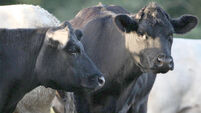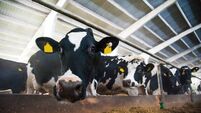Quota situation could be even worse in 2014
Once-a-day milking is an option that will reduce milk production by almost 30%, but is not suitable for many farmers due to SCC and other problems.
For the past three decades, developments on Irish dairy farms have been severely restricted by milk quotas.
The incomes of farmers who were at a low level of development at the start of quota restrictions have been especially curtailed, and many of them have been forced out of dairying.
Despite the quota restrictions, many dairy farmers have made great strides in the efficiency of milk production and are in good shape facing into the post quota era.
However, some farmers seem to be in denial about quotas, and have suffered severe losses in terms of superlevy and restricting milk production, often through poor practices.
The advice regarding quota management is very simple and has been repeated in these columns many times during the past 30 years.
Hopefully for the last time, I will repeat it — match cow numbers with available quota plus an extra 10% to 15% which can be produced if the opportunity arises.
Serious over-quota problems face many dairy farmers at present. Due to wrong advice to calve down extra heifer next spring, the situation is likely to be even worse this time next year, if the weather is near normal.
When taking steps to mitigate over-quota problems this spring, bear in mind how many animals you will need to be calving down next spring to stay within quota until Mar 31, 2015.
If you are severely over-quota at present there is no satisfactory solution, but there are some steps that will minimise the problem. Remember when taking these steps that all animals must be fed properly, or there will be long-term consequences. Selling surplus animals, especially if you have a lot of heifers calving early next spring, or culling undesirables is an obvious choice.
Feeding a 12-14% ration will reduce milk production and maintain condition.
Once-a-day milking will reduce milk production almost 30%, but is not suitable for many farms, due to SCC and other problems.
Feeding fairly high levels of milk to calves also helps. Don’t underfeed cows after calving, as this could reduce fertility by over 50%.
Lactation length
As mentioned in these pages last week, the most obvious post-quota change for most farmers is to lengthen lactations. Average lactations on most Irish farms are only about 240 to 270 days.
This is due mainly to late calving, and on many farms, to having too many cows for available quota.
The long-term solution to this problem is an earlier start to calving, with replacements calving early, and planning for a long grazing season. In the short term, for the coming seasons, the aim should be to milk every cow for close to 300 days (assuming quota is available).
This should improve profit by around 5 cent per gallon on farms averaging 250-day lactations, assuming the cows are properly fed until the end of their lactations.
Teagasc have shown that a standard 300-day lactation is the most profitable system of milk production. This allows an eight to 10 week dry period, which is optimum in most situations, and optimum yields of high protein milk from the minimum number of cows. With very good fertility, it also facilitates a good break from milking at around Christmastime. But a more normal fertility performance requires a reduced average lactation length of about 285 days, to give a reasonable winter break, and is a labour/lifestyle/profit, compromise.
Farmers will make lose 11.1 cent per gallon with a 215-day lactation, compared with a 300-day lactation. This represents a loss of €5,500 on a 50,000 gallon quota. At processing level, short lactations also incur a lot of extra expense, due to a sharp peak /trough supply ratio resulting in only 60% utilisation of Irish processing facilities.
Short lactations do have some advantages in terms of lifestyle, but for the average farmer’s herd — which would have lactations of about 250 days — there is a loss of about €3,000 as compared with opting for 300-day lactations.
This could be a lifestyle issue, especially with volatile milk prices. Dairy farmers justifiably like a break from milking in December or early January, but late calving and infertility can make this a costly exercise. With a good supply of quality replacements coming on stream, it should be easier to establish compact earlier calving.









